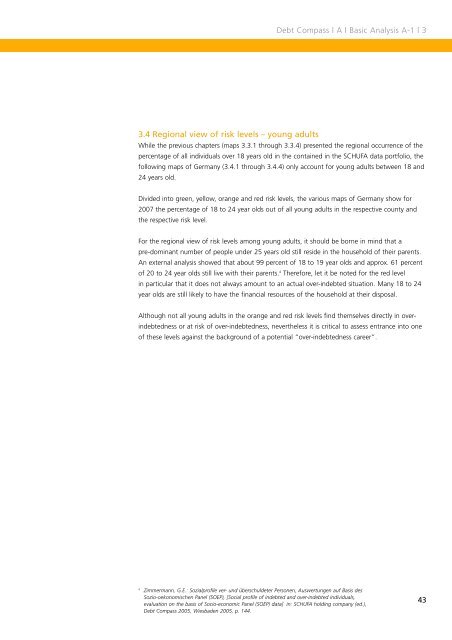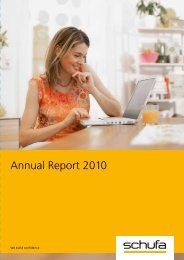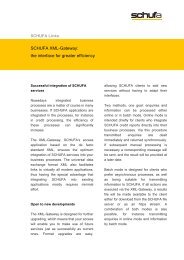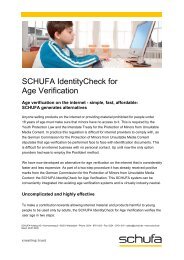Abridged English version of the SCHUFA Credit Compass 2008
Abridged English version of the SCHUFA Credit Compass 2008
Abridged English version of the SCHUFA Credit Compass 2008
Create successful ePaper yourself
Turn your PDF publications into a flip-book with our unique Google optimized e-Paper software.
Debt <strong>Compass</strong> | A | Basic Analysis A-1 | 3<br />
3.4 Regional view <strong>of</strong> risk levels – young adults<br />
While <strong>the</strong> previous chapters (maps 3.3.1 through 3.3.4) presented <strong>the</strong> regional occurrence <strong>of</strong> <strong>the</strong><br />
percentage <strong>of</strong> all individuals over 18 years old in <strong>the</strong> contained in <strong>the</strong> <strong>SCHUFA</strong> data portfolio, <strong>the</strong><br />
following maps <strong>of</strong> Germany (3.4.1 through 3.4.4) only account for young adults between 18 and<br />
24 years old.<br />
Divided into green, yellow, orange and red risk levels, <strong>the</strong> various maps <strong>of</strong> Germany show for<br />
2007 <strong>the</strong> percentage <strong>of</strong> 18 to 24 year olds out <strong>of</strong> all young adults in <strong>the</strong> respective county and<br />
<strong>the</strong> respective risk level.<br />
For <strong>the</strong> regional view <strong>of</strong> risk levels among young adults, it should be borne in mind that a<br />
pre-dominant number <strong>of</strong> people under 25 years old still reside in <strong>the</strong> household <strong>of</strong> <strong>the</strong>ir parents.<br />
An external analysis showed that about 99 percent <strong>of</strong> 18 to 19 year olds and approx. 61 percent<br />
<strong>of</strong> 20 to 24 year olds still live with <strong>the</strong>ir parents. 4 Therefore, let it be noted for <strong>the</strong> red level<br />
in particular that it does not always amount to an actual over-indebted situation. Many 18 to 24<br />
year olds are still likely to have <strong>the</strong> financial resources <strong>of</strong> <strong>the</strong> household at <strong>the</strong>ir disposal.<br />
Although not all young adults in <strong>the</strong> orange and red risk levels find <strong>the</strong>mselves directly in overindebtedness<br />
or at risk <strong>of</strong> over-indebtedness, never<strong>the</strong>less it is critical to assess entrance into one<br />
<strong>of</strong> <strong>the</strong>se levels against <strong>the</strong> background <strong>of</strong> a potential “over-indebtedness career”.<br />
4 Zimmermann, G.E.: Sozialpr<strong>of</strong>ile ver- und überschuldeter Personen, Auswertungen auf Basis des<br />
Sozio-oekonomischen Panel (SOEP), [Social pr<strong>of</strong>ile <strong>of</strong> indebted and over-indebted individuals,<br />
evaluation on <strong>the</strong> basis <strong>of</strong> Socio-economic Panel (SOEP) data] in: <strong>SCHUFA</strong> holding company (ed.),<br />
Debt <strong>Compass</strong> 2005, Wiesbaden 2005, p. 144.<br />
43
















